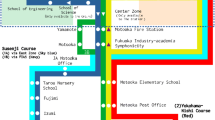Abstract
This paper addresses the problem of predicting bus travel time over unstable intervals between two adjacent bus stops using two types of machine learning techniques: ANN and SVR methods. Our model considers the variability of travel time because the travel time is often influenced by stochastic factors, which increase the variance of travel time over an interval between inter-time periods. The factors also affect the variance of the travel time over the interval at the same time period between inter-days. In addition, the factors show some correlation of travel time over the interval between time periods in a day. The performance of the proposed model is validated with real bus probe data collected from November 21st to December 20th, 2013, provided by Nishitetsu Bus Company, Fukuoka, Japan. We demonstrated the impact of two types of input variables for the prediction in off- and on-peak (rush hour) periods. The results show that the two types of inputs can effectively improve the prediction accuracy. Moreover, we compared the proposed method with our previous methods. The experimental results show the validity of our proposed method.






Similar content being viewed by others
Explore related subjects
Discover the latest articles and news from researchers in related subjects, suggested using machine learning.References
AS, M., MINE, T.: Empirical study of travel time variability using bus probe data. Agents (ICA), IEEE International Conference on. IEEE. 146–149 (2016)
AS, Mansur; MINE, Tsunenori. Estimation of travel time variability using bus probe data. In: 6th IEEE international conference on advanced logistics and transport (ICALT). IEEE 2017, pp.68–74
AS, Mansur; MINE, Tsunenori. Dynamic bus travel time prediction using an ANN-based model. In: Proceedings of the 12th International Conference on Ubiquitous Information Management and Communication. ACM, 2018. p. 20
AS, Mansur; MINE, Tsunenori. An adaptive approach for predicting bus travel time over unstable intervals. In: The 16th ITS Asia-Pacific forum FUKUOKA. ITS Asia Pacific and ITS Japan 2018, pp. 146–160
YU, B., et al.: An adaptive bus arrival time prediction model. Journal of the Eastern Asia Society for Transportation Studies. 8, 1126–1136 (2010)
CORTES, C., VAPNIK, V.: Support-vector networks. Mach. Learn. 20(3), 273–297 (1995)
BERREBI, S.J., et al.: Comparing bus holding methods with and without real-time predictions. Transportation Research Part C: Emerging Technologies. 2017,
BAI, C., et al.: Dynamic bus travel time prediction models on road with multiple bus routes. Computational intelligence and neuroscience. 2015, 63 (2015)
KUMAR, S.V., VANAJAKSHI, L.: Urban arterial travel time estimation using buses as probes. Arab. J. Sci. Eng. 39(11), 7555–7567 (2014)
MISHRA, S., et al.: Estimation and valuation of travel time reliability for transportation planning applications. Case Studies on Transport Policy. 2017,
PATNAIK, J., CHIEN, S., BLADIKAS, A.: Estimation of bus arrival times using APC data. Journal of public transportation. 7(1), 1–20 (2004)
YU, B., et al.: Hybrid model for prediction of bus arrival times at next station. J. Adv. Transp. 44(3), 193–204 (2010)
WESTGATE, B.S., et al.: Large-network travel time distribution estimation for ambulances. Eur. J. Oper. Res. 252(1), 322–333 (2016)
XINGHAO, S., et al.: Predicting bus real-time travel time basing on both GPS and RFID data. Procedia Soc. Behav. Sci. 96, 2287–2299 (2013)
AMITA, J., SINGH, J.S., KUMAR, G.P.: Prediction of bus travel time using artificial neural network. International Journal for Traffic and Transport Engineering. 5(4), 410–424 (2015)
SUWARDO, W., NAPIAH, M., Ibrahim, K.A.M.A.R.U.D.D.I.N.: ARIMA models for bus travel time prediction. Journal of the institute of engineers Malaysia. 49–58 (2010)
YILMAZ, I.: Comparison of landslide susceptibility mapping methodologies for Koyulhisar, Turkey: conditional probability, logistic regression, artificial neural networks, and support vector machine. Environmental Earth Sciences. 61(4), 821–836 (2010)
MÜLLER, K.-R., et al.: Predicting Time Series with Support Vector Machines. In: International Conference on Artificial Neural Networks. Springer, pp. 999–1004. Berlin, Heidelberg (1997)
SHALABY, A., FARHAN, A.: Prediction model of bus arrival and departure times using AVL and APC data. Journal of Public Transportation. 7(1), 3 (2004)
GAL, A., et al.: Traveling time prediction in scheduled transportation with journey segments. Inf. Syst. 64, 266–280 (2017)
MAZLOUMI, E., et al.: Using SCATS data to predict bus travel time. In: 32nd Australian Transport Research Forum (ATRF), p. 2009. Auckland, New Zealand
Lelitha, V.A.N.A.J.A.K.S.H.I., RILETT, Laurence, R.: Support vector machine technique for the short term prediction of travel time. In: Intelligent vehicles symposium, 2007 IEEE. IEEE. 600–605 (2007)
CHANG, C.-C., LIN, C.-J.: LIBSVM: a library for support vector machines. ACM transactions on intelligent systems and technology (TIST). 2(3), (2011)
Acknowledgments
The probe data used in this study were provided by NISHITETSU Bus Company in Fukuoka, Japan. This work is partially supported by JSPS KAKENHI Grant Number JP15H05708.
Author information
Authors and Affiliations
Corresponding author
Additional information
Publisher’s Note
Springer Nature remains neutral with regard to jurisdictional claims in published maps and institutional affiliations.
Rights and permissions
About this article
Cite this article
As, M., Mine, T. & Yamaguchi, T. Prediction of Bus Travel Time Over Unstable Intervals between Two Adjacent Bus Stops. Int. J. ITS Res. 18, 53–64 (2020). https://doi.org/10.1007/s13177-018-0169-3
Received:
Revised:
Accepted:
Published:
Issue Date:
DOI: https://doi.org/10.1007/s13177-018-0169-3




